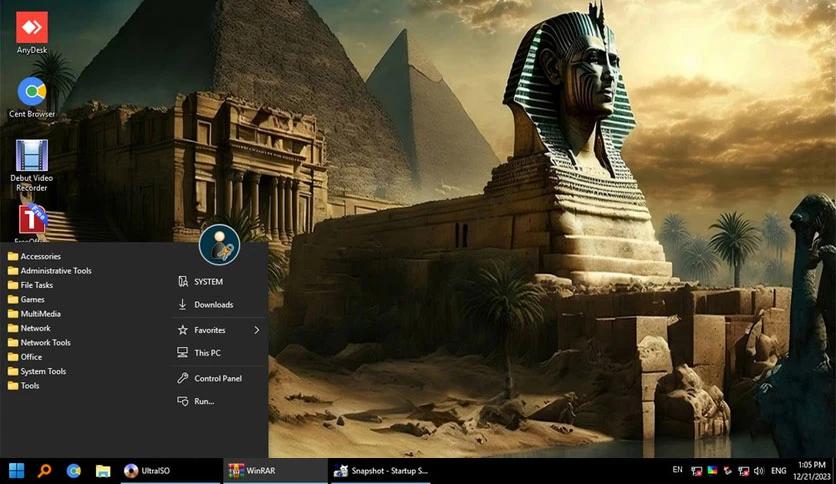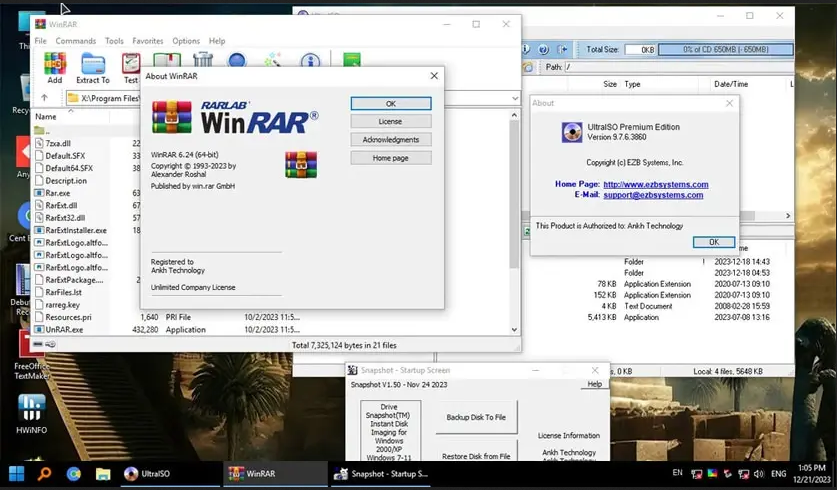
Software Contents
ToggleAnkh Technology Emergency OS: A Comprehensive Overview
Ankh Technology Emergency OS 6.0 In an era where the speed of technological advancements is astonishing, software systems face increasing demands to provide reliability, security, and efficiency. One area requiring special attention within software development is emergency response systems. Ankh Technology’s Emergency OS is an innovative, adaptable operating system designed to address the unique challenges faced by emergency services. In this article, we will explore the key features, benefits, potential applications, and future implications of Ankh Technology’s Emergency OS.

Introduction to Ankh Technology
Ankh Technology is at the forefront of developing cutting-edge technologies aimed at improving critical system processes. With a focus on emergency management, their Emergency OS was designed to facilitate communication, information sharing, and decision-making processes during emergency situations. As emergency service providers face growing challenges, including natural disasters, pandemics, and urban incidents, Ankh Technology’s solutions aim to enhance responsiveness, improve coordination, and streamline workflows for emergency responders.
Understanding Emergency Operating Systems
Emergency operating systems (OS) serve the critical purpose of supporting emergency management operations. Unlike traditional operating systems that cater to general computing needs, Emergency OS environments are tailored for high-pressure situations where rapid decision-making and effective communication are imperative. Here are some characteristics that define Emergency OS:
- Real-Time Processing: Emergency OS must handle real-time data and enable immediate responses to incidents. Delays can have severe consequences during emergencies, making speed a primary factor.
- Robust Security: Protecting sensitive information is crucial, especially in scenarios involving personal health data, law enforcement, and community safety.
- Interoperability: Many different agencies and services often respond to emergencies. An effective Emergency OS facilitates communication and information sharing between diverse systems.
- User-Friendly Interfaces: Emergency responders must access information quickly and efficiently. Streamlined interfaces cater specifically to users in high-pressure situations.

Key Features of Ankh Technology Emergency OS
Ankh Technology’s Emergency OS is built with a suite of features designed to enhance the capabilities of emergency services. Some of the critical elements include:
1. Dynamic Response Architecture
The Emergency OS incorporates a dynamic response architecture, allowing it to adapt to various types of emergencies, whether a natural disaster, medical crisis, or public safety issue. This feature includes modular designs that enable easy updates and customization according to specific operational needs.
2. Integrated Communication Systems
One of the most significant challenges during emergencies is communication breakdowns. Ankh Technology’s Emergency OS includes integrated communication features that allow seamless connectivity between first responders, command centers, and the public. This includes features like:
- Real-time chat and voice communication
- Location tracking and geofencing
- Broadcast capabilities for alerts and updates
3. Data Aggregation and Analytics
An essential function of Emergency OS is its ability to collect and analyze data in real time. The system can gather information from various sources, including social media feeds, sensor data, and user reports. This data is aggregated and analyzed to provide actionable insights. Features include:
- Predictive analytics to assess potential risks
- Heat maps highlighting high-incident areas
- Resource allocation tools
4. Multi-Agency Coordination Tools
Emergencies often require collaboration among multiple agencies, including police, fire departments, medical services, and NGOs. Ankh Technology’s Emergency OS includes coordination tools designed to manage multi-agency operations effectively. These tools support:
- Multi-agency task forces
- Shared dashboards for situation awareness
- Unified command structures for policy implementation
5. Disaster Recovery and Continuity Planning
In emergencies, plans must remain in place for disaster recovery and business continuity. Ankh Technology ensures that its Emergency OS includes robust disaster recovery features to safeguard data, maintain operations, and facilitate seamless transitions in the event of system failure. Key features include:
- Data backups
- System rollback options
- Comprehensive continuity planning guidelines
6. Mobile Accessibility
With responders in the field, access to critical information on mobile devices is essential. Emergency OS applications are designed for smartphones and tablets, ensuring that responders can utilize the system from any location, allowing for adaptive resource management.
Benefits of Ankh Technology Emergency OS
1. Improved Response Times
With real-time data processing, integrated communication, and streamlined workflows, emergency responders equipped with Ankh Technology’s Emergency OS can react more rapidly during crisis situations.
2. Enhanced Decision Making
The system’s data analytics capabilities offer responders actionable insights that enhance decision-making processes. The availability of vital information facilitates informed, timely actions that can save lives.
3. Increased Collaboration
By enabling better communication and coordination among multiple agencies, Emergency OS reduces the potential for confusion during emergencies, leading to cohesive actions and improved outcomes.
4. Greater Public Safety
The Emergency OS can also allow authorities to manage public information more effectively, enhancing community safety and awareness during crises.
5. Cost Efficiency
Organizational efficiencies gained through improved response mechanisms can lead to reduced costs and resource usage, allowing for better allocation of emergency service budgets.
Application Scenarios for Ankh Technology Emergency OS
Ankh Technology’s Emergency OS has a broad range of applications in different emergency scenarios. A few example use cases include:
1. Natural Disasters
During natural disasters such as hurricanes, earthquakes, or floods, immediate coordination between local, state, and federal agencies is vital. Emergency OS can aid in the rapid deployment of resources, track personnel, and provide real-time updates to affected communities.
2. Medical Emergencies
During a public health crisis or mass casualty incident, Emergency OS can facilitate communication between emergency medical services, hospitals, and disaster response teams. The system aids in triaging patients, tracking hospital capacities, and routing ambulances efficiently.
3. Terrorism and Active Shooter Situations
In critical incidents such as terrorism events or active shooter scenarios, efficient coordination and real-time information sharing are crucial. The Emergency OS provides law enforcement agencies with communication tools that assist in real-time alerts and resource management.
4. Community Emergency Preparedness
Beyond reactive crisis management, Ankh Technology also focuses on proactive emergency preparedness. The Emergency OS can be employed in training simulations, providing community education initiatives on preparedness measures and emergency response.
Challenges and Considerations
While Ankh Technology’s Emergency OS offers notable benefits, there are challenges and considerations that need to be addressed:
1. Integration with Existing Systems
Many emergency services already have established systems. Transitioning to a new OS can be challenging, requiring careful planning, training, and integration efforts to ensure compatibility and functionality across various platforms.
2. Data Privacy and Security Concerns
Given the sensitive nature of data processed during emergencies, it is vital for the Emergency OS to maintain robust security protocols. Ankh Technology must address concerns around data breaches and privacy while ensuring interoperability among agencies.
3. Training and Adaptation
For the Emergency OS to be effective, thorough training for users is essential. First responders must be comfortable with the new systems and workflows, which can be resource-intensive and time-consuming.

Future Trends and Developments
As technology continues to evolve, so will Ankh Technology’s Emergency OS. Future trends impacting emergency management systems include:
1. Artificial Intelligence and Machine Learning
Integrating AI and machine learning can enhance predictive analytics, assist in resource allocation, and automate routine tasks. Adapting these technologies can power even more efficient emergency response strategies.
2. IoT Integration
The Internet of Things (IoT) can provide real-time data input from various sources, including sensors deployed in disaster zones or smart city infrastructure. Ankh Technology’s Emergency OS can leverage IoT data for immediate situational awareness.
3. Enhanced User Interfaces
Future iterations of the Emergency OS will focus on improving user experience. This includes more intuitive interfaces and virtual reality training modules to prepare responders for high-stress scenarios.
4. Global Collaboration
As climate change and globalization lead to increased disaster frequency, collaboration among global emergency management organizations will be essential. Ankh Technology’s Emergency OS can enable international information sharing and coordinated responses, preparing regions for collective readiness.
Conclusion
Ankh Technology’s Emergency OS represents a significant advancement in the field of emergency management systems. By integrating real-time data processing, enhanced communication, and advanced analytical tools, this operating system empowers first responders in navigating the complexities of emergencies more efficiently. The focus on collaboration, user experience, and security highlights the necessity of a sophisticated approach to emergency preparedness and response.
In a world where emergencies are increasingly frequent and complex, solutions like Ankh Technology’s Emergency OS can play a crucial role in saving lives, enhancing responses, and creating safer communities. As technology continues to progress, the potential of Emergency OS will expand, offering even more significant benefits to society’s most critical response systems.





thanks very nice 👍👍👍👍👍🤷♀️🤷♀️🤷♀️👌👌👌👌
I am Najeeb,i download Ankh technology from Naazpc,i am Happy from Naazpc